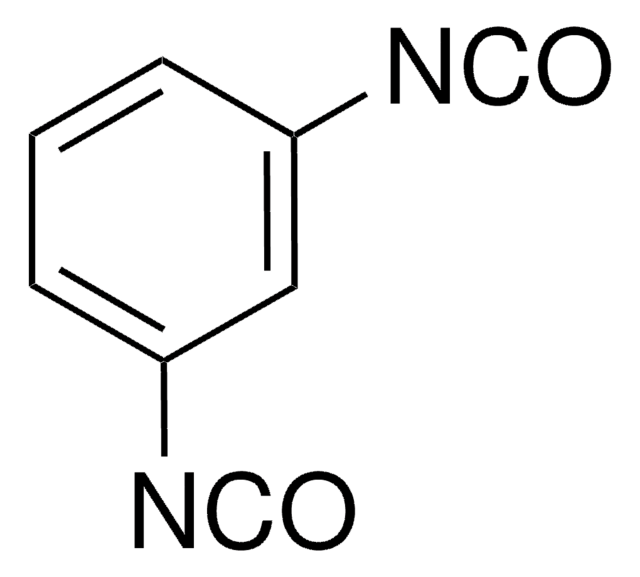Products may be shipped at a different temperature than the recommended long-term storage temperature. If the product quality is sensitive to short-term exposure to conditions other than the recommended long-term storage, it will be shipped on wet or dry-ice. If the product quality is NOT affected by short-term exposure to conditions other than the recommended long-term storage, it will be shipped at ambient temperature. As shipping routes are configured for minimum transit times, shipping at ambient temperature helps control shipping costs for our customers. For more information, please refer to the Storage and Transport Conditions document: https://www.sigmaaldrich.com/deepweb/assets/sigmaaldrich/marketing/global/documents/316/622/storage-transport-conditions-mk.pdf
262242
1,4-Phenylene diisocyanate
Synonym(s):
1,4-Diisocyanatobenzene, p-Phenylene diisocyanate
About This Item
Recommended Products
vapor pressure
<0.01 mmHg ( 20 °C)
Quality Level
form
solid
bp
260 °C (lit.)
mp
96-99 °C (lit.)
solubility
THF: soluble
acetone: soluble
ethyl acetate: soluble
toluene: soluble
functional group
isocyanate
SMILES string
O=C=Nc1ccc(cc1)N=C=O
InChI
1S/C8H4N2O2/c11-5-9-7-1-2-8(4-3-7)10-6-12/h1-4H
InChI key
ALQLPWJFHRMHIU-UHFFFAOYSA-N
Related Categories
Application
- A reactant to synthesize high yield polymers via criss-cross addition polymerization reaction with alkyl aldazines in pyridine.[1]
- An organic building block to prepare adamantyl-containing diurea and thiourea derivatives applicable as potent mammalian and human soluble epoxide hydrolase inhibitors.[2]
- A coupling agent to synthesize polyethylene glycol (PEG)/silica composite material using dibutyltin dilaurate (DBTDL) as a catalyst.[3]
It can also be used:
- As a cross-linking reagent to investigate the mechanism of enzyme immobilization on silanized surfaces.[4]
- In the synthesis of the dipodal bis-urea receptor, a selective receptor for hydrogen sulfate.[5]
- In the deposition of polyurea resists films via molecular layer deposition.[6]
Signal Word
Danger
Hazard Statements
Precautionary Statements
Hazard Classifications
Acute Tox. 2 Inhalation - Aquatic Chronic 2 - Eye Irrit. 2 - Resp. Sens. 1 - Skin Irrit. 2 - Skin Sens. 1
Storage Class Code
6.1A - Combustible acute toxic Cat. 1 and 2 / very toxic hazardous materials
WGK
WGK 3
Flash Point(F)
>235.4 °F - closed cup
Flash Point(C)
> 113 °C - closed cup
Personal Protective Equipment
Choose from one of the most recent versions:
Already Own This Product?
Find documentation for the products that you have recently purchased in the Document Library.
Customers Also Viewed
-
How is shipping temperature determined? And how is it related to the product storage temperature?
1 answer-
Helpful?
-
-
How can I determine the shelf life / expiration / retest date of this product?
1 answer-
If this product has an expiration or retest date, it will be shown on the Certificate of Analysis (COA, CofA). If there is no retest or expiration date listed on the product's COA, we do not have suitable stability data to determine a shelf life. For these products, the only date on the COA will be the release date; a retest, expiration, or use-by-date will not be displayed.
For all products, we recommend handling per defined conditions as printed in our product literature and website product descriptions. We recommend that products should be routinely inspected by customers to ensure they perform as expected.
For products without retest or expiration dates, our standard warranty of 1 year from the date of shipment is applicable.
For more information, please refer to the Product Dating Information document: https://www.sigmaaldrich.com/deepweb/assets/sigmaaldrich/marketing/global/documents/449/386/product-dating-information-mk.pdfHelpful?
-
Active Filters
Our team of scientists has experience in all areas of research including Life Science, Material Science, Chemical Synthesis, Chromatography, Analytical and many others.
Contact Technical Service















